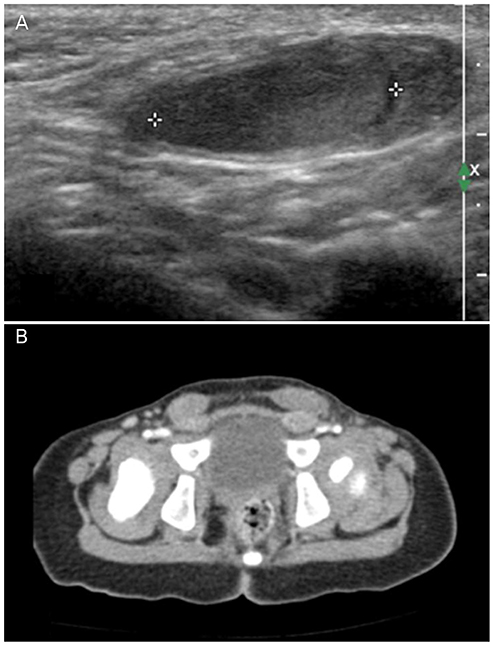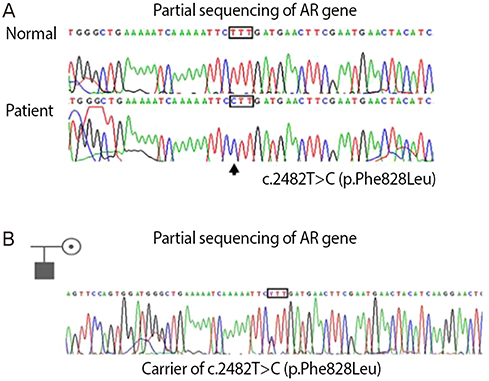Obstet Gynecol Sci.
2015 Mar;58(2):179-182. 10.5468/ogs.2015.58.2.179.
Polycystic ovary syndrome woman with heterozygous androgen receptor gene mutation who gave birth to a child with androgen insensitivity syndrome
- Affiliations
-
- 1Division of Reproductive Endocrinology and Infertility, Department of Obstetrics and Gynecology, University of Ulsan College of Medicine, Asan Medical Center, Seoul, Korea. chnkim@amc.seoul.kr
- 2Medical Genetic Center, University of Ulsan College of Medicine, Asan Medical Center, Seoul, Korea.
- KMID: 2314044
- DOI: http://doi.org/10.5468/ogs.2015.58.2.179
Abstract
- Polycystic ovary syndrome (PCOS) is one of the most common endocrine disorders in women of reproductive age, and it is a multifactorial polygenic disorder with a broad spectrum of clinical manifestations. Although pathogenesis is still unclear, androgen receptor (AR) gene polymorphism may be one of the etiologic factors of PCOS. AR gene polymorphism has been also associated with other forms of androgen pattern diseases. We report a PCOS woman with heterozygous AR gene mutation who gave birth to a baby with andorgen insensitivity syndrome.
Keyword
MeSH Terms
Figure
Reference
-
1. Franks S. Polycystic ovary syndrome. N Engl J Med. 1995; 333:853–861.2. Ehrmann DA. Polycystic ovary syndrome. N Engl J Med. 2005; 352:1223–1236.3. Chamberlain NL, Driver ED, Miesfeld RL. The length and location of CAG trinucleotide repeats in the androgen receptor N-terminal domain affect transactivation function. Nucleic Acids Res. 1994; 22:3181–3186.4. Hickey T, Chandy A, Norman RJ. The androgen receptor CAG repeat polymorphism and X-chromosome inactivation in Australian Caucasian women with infertility related to polycystic ovary syndrome. J Clin Endocrinol Metab. 2002; 87:161–165.5. Ferk P, Perme MP, Teran N, Gersak K. Androgen receptor gene (CAG)n polymorphism in patients with polycystic ovary syndrome. Fertil Steril. 2008; 90:860–863.6. Skrgatic L, Baldani DP, Cerne JZ, Ferk P, Gersak K. CAG repeat polymorphism in androgen receptor gene is not directly associated with polycystic ovary syndrome but influences serum testosterone levels. J Steroid Biochem Mol Biol. 2012; 128:107–112.7. Lin LH, Baracat MC, Maciel GA, Soares JM Jr, Baracat EC. Androgen receptor gene polymorphism and polycystic ovary syndrome. Int J Gynaecol Obstet. 2013; 120:115–118.8. Brown TR, Lubahn DB, Wilson EM, Joseph DR, French FS, Migeon CJ. Deletion of the steroid-binding domain of the human androgen receptor gene in one family with complete androgen insensitivity syndrome: evidence for further genetic heterogeneity in this syndrome. Proc Natl Acad Sci U S A. 1988; 85:8151–8155.9. Galani A, Kitsiou-Tzeli S, Sofokleous C, Kanavakis E, Kalpini-Mavrou A. Androgen insensitivity syndrome: clinical features and molecular defects. Hormones. 2008; 7:217–229.10. Rotterdam ESHRE/ASRM-Sponsored PCOS Consensus Workshop Group. Revised 2003 consensus on diagnostic criteria and long-term health risks related to polycystic ovary syndrome. Fertil Steril. 2004; 81:19–25.11. Beitel LK, Scanlon T, Gottlieb B, Trifiro MA. Progress in Spinobulbar muscular atrophy research: insights into neuronal dysfunction caused by the polyglutamine-expanded androgen receptor. Neurotox Res. 2005; 7:219–230.12. Morris JM. The syndrome of testicular feminization in male pseudohermaphrodites. Am J Obstet Gynecol. 1953; 65:1192–1211.13. Werner R, Holterhus PM, Binder G, Schwarz HP, Morlot M, Struve D, et al. The A645D mutation in the hinge region of the human androgen receptor (AR) gene modulates AR activity, depending on the context of the polymorphic glutamine and glycine repeats. J Clin Endocrinol Metab. 2006; 91:3515–3520.
- Full Text Links
- Actions
-
Cited
- CITED
-
- Close
- Share
- Similar articles
-
- A Case Report of Complete Androgen Insensitivity Syndrome
- Complete androgen insensitivity syndrome due to androgen receptor gene mutation in the amino acid position 607 which bilateral testes situated in the normal ovary sites
- A Family Case of Complete Androgen Insensitivity Syndrome in Sisters due to a Novel Mutation in the Androgen Receptor Gene
- A Case of Laparoscopic Gonadectomy in Complete Androgen Insensitivity Syndrome
- Partial Androgen Insensitivity Syndrome Presenting with Gynecomastia



